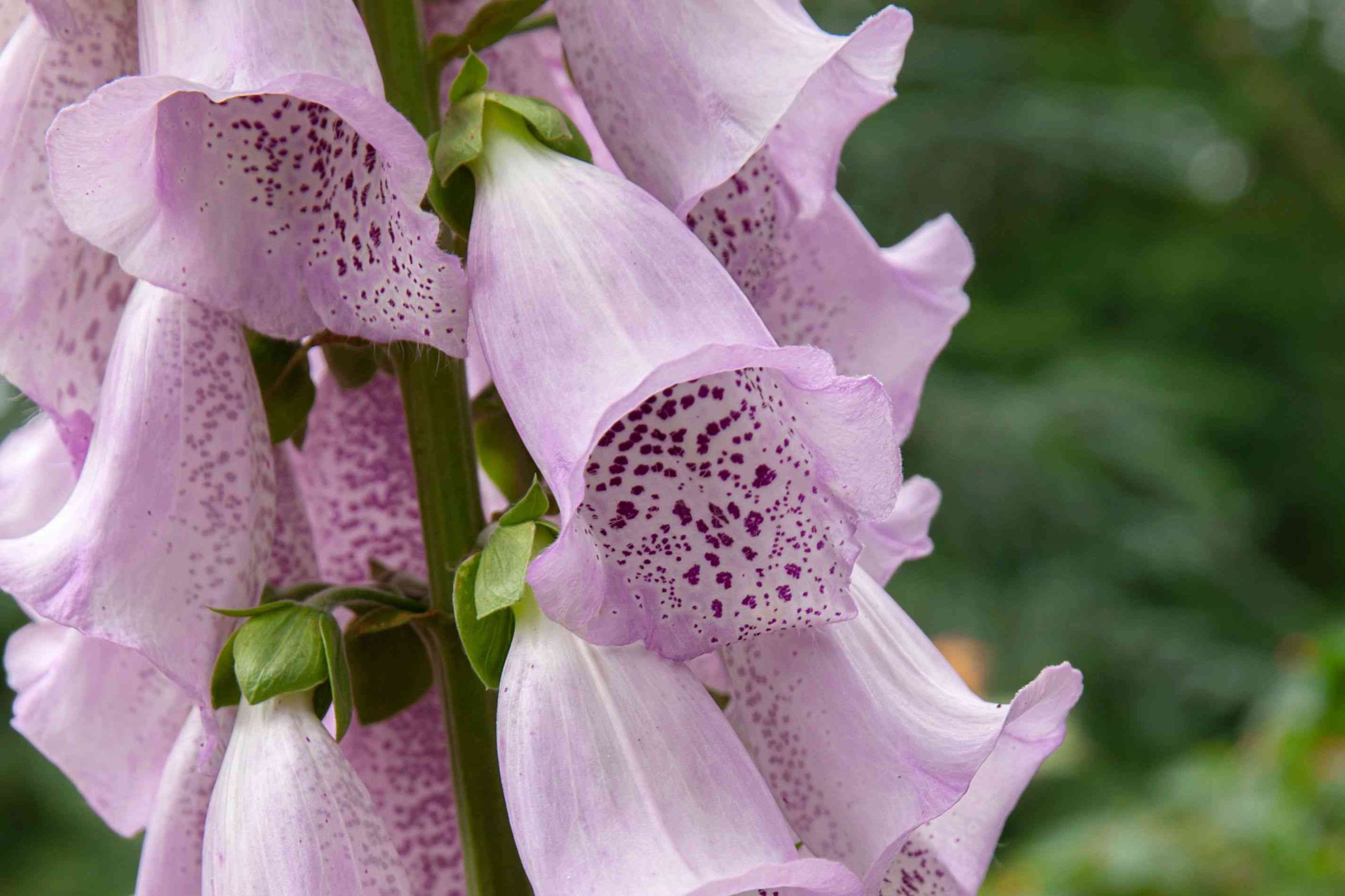With its tall, spiky blooms in shades of purple, pink, and white, the foxglove plant brings drama and sophistication to any garden. Foxgloves have an old-fashioned cottage garden appeal that looks absolutely lovely in borders or containers. If you want to add vertical interest and summer color that also attracts hummingbirds, read on for everything you need to know about growing foxglove, plus plenty of beautiful foxglove pictures to inspire your planting.
An Overview of the Foxglove Plant
Foxgloves (Digitalis purpurea) are biennials or short-lived perennials prized for their showy, tubular flowers borne on tall stalks. During the first year of growth, foxgloves form a low rosette of fuzzy green leaves. In their second year of growth, they send up one or more flower spikes rising 3-5 feet tall depending on variety.
The elongated flower clusters are covered in dozens of drooping, bell-shaped blooms that dangle like fairy gloves. The blossoms open gradually from the bottom up over a period of weeks for a prolonged display of color. When not in flower, foxgloves are still attractive for their basal rosette of leaves.
Native to parts of Europe and the Mediterranean foxgloves thrive in USDA zones 4-10 and grow best in full sun to part shade. They prefer moist, well-draining soil and cool conditions. Hot southern summers cause them to fade out or go dormant until cooler weather returns.
In addition to their beauty foxgloves have a long history of medicinal use dating back to Roman times. However the plant also contains toxic cardiac glycosides, so caution is required. When handling foxgloves, it’s advisable to wear gloves to avoid skin irritation.
The Many Beautiful Colors and Varieties of Foxglove Flowers
One of the best qualities of Digitalis is the diversity of flower colors and varieties available. Here are some of the most popular types to consider:
-
Common Foxglove – Heirloom variety with deep purple blooms rising 3-5 feet tall.
-
‘Alba’ – A statuesque variety bearing pure white, gracefully hanging bells up to 4 feet tall.
-
‘Sutton’s Apricot’ – Warm peachy-orange blooms on sturdy 4-foot stems.
-
‘Camelot Lavender’ – Profuse flowers in soft lavender shades; a first year blooming variety.
-
‘Dalmatian Purple’ – Deep purple bells generously speckled inside. Grows 18-24 inches tall.
-
‘Foxy’ – Multicolored blooms in shades of deep rose, pink, cream, yellow and white. Height around 3 feet.
-
‘Pam’s Choice’ – Prolific bloomer with extra large, pink and white bicolor flowers on strong stems.
How to Plant and Care for Foxgloves
Foxgloves give the best performance when provided with the right growing conditions. Here are some tips:
-
Plant in spring or fall in full sun to part shade. They excel along borders, next to fences or buildings, or in containers.
-
Amend soil with compost or aged manure to improve drainage and nutrients. Foxgloves dislike wet feet.
-
Space plants 18-24 inches apart. Taller varieties may need support from stakes.
-
Water first year plants regularly until established. Mature plants tolerate some drought once rooted firmly.
-
Apply a general purpose fertilizer at planting and again in early spring as growth resumes.
-
Remove the main flower stalk after blooming to encourage side shoots and prolong the display.
-
Allow some seedheads to mature in order to self-sow for future generations of foxglove.
-
Cut back faded foliage in late fall once it has died back. Mulch plants to protect the crown over winter.
Growing Foxgloves from Seed
Many gardeners opt to grow foxgloves from seed, as it’s an inexpensive way to produce many plants. Sow seeds in late summer or early fall. Cover very lightly with soil or simply press into the ground. Germination occurs the following spring. Thin seedlings or transplant to final spacing. Be patient – foxgloves grown from seed may not bloom until their second year of growth.
Companion Planting for Foxgloves
The vertical flower spikes of foxgloves beautifully complement many other cottage garden favorites. Consider combining them with plants like:
- Catmint
- Lavender
- Salvia
- Roses
- Poppies
- Delphiniums
- Yarrow
- Veronica
- Coreopsis
- Lady’s Mantle
This classic mixture of perennials and self-sowing annuals will give you a gracefully informal garden that changes through the seasons.
Pictures of Gorgeous Foxglove Flowers
The tubular, bell-like shape of foxglove blooms adds unique texture and sophistication to the garden. Here are some pictures showcasing their elegant beauty:
![A field of wild foxgloves blooming with purple and white flowers. The bell-shaped blooms dangle from tall, upright stalks.][]
Foxgloves blooming en masse in soft shades of purple and white.![Close up photo showing a single purple foxglove bloom with white speckled interior against a green background.][]
A close perspective highlights the delicately speckled interior of this foxglove bloom.![A massive flower spike densely packed with purple foxglove blooms rises above the green foliage background.][]
Foxglove’s impressive vertical form makes it a stunning garden accent.![Soft pink foxglove flowers illuminate a shaded garden area. Other plants include ferns and hostas.][]
The soft pink coloring of some foxglove varieties lights up shady garden corners.
Incorporating foxgloves into your garden, whether in masses or as solo accents, is sure to add a touch of old-world charm and whimsy. Let these pictures inspire your own foxglove plantings!
My Experience with Foxglove! // Garden Answer
FAQ
Do foxgloves come back every year?
Is foxglove poisonous to touch?
What do perennial foxgloves look like?
Do foxglove plants spread?
- The Ultimate Guide to Growing Strawberries in Raised Beds - August 8, 2025
- No-Dig Garden Beds: The Easiest Way to Grow a Beautiful Garden - August 6, 2025
- How to Protect and Preserve Wood for Raised Garden Beds - August 6, 2025

